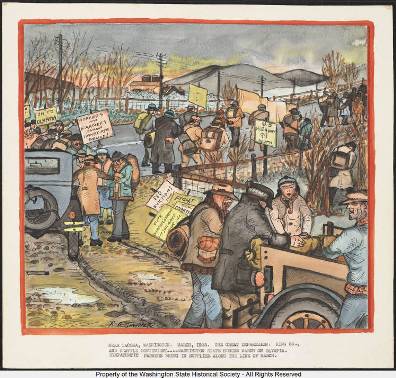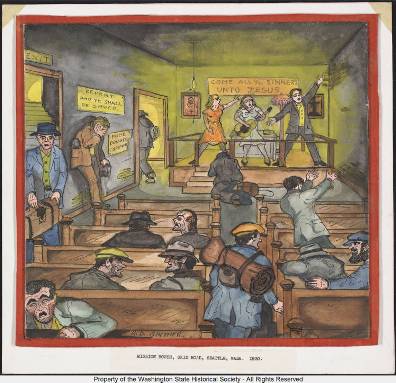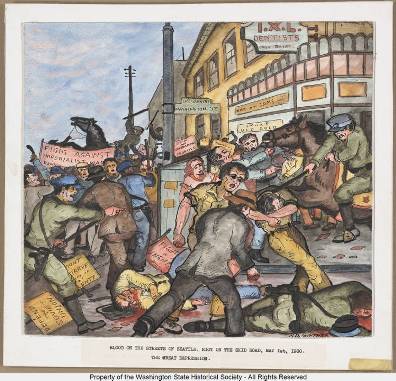Ronald Ginther Watercolors
Documentary photography is the art form most often associated with the 1930s. Americans today look back on the Great Depression through the lens of Dorothea Lange and the other photographers of that era. Washington state is privileged to be able to view this era not just in black and white but also in the rich colors and vivid action scenes that were the special gift of watercolor artist Ronald Debs "Ray" Ginther.
Ginther produced more than 80 paintings that are now owned by the Washington State Historical Society. They are a unique resource, depicting the rough life of Hoovervilles and homeless men, of jails and soup kitchens, unemployed demonstrations and police attacks, strikes and radical protests. Some were produced in the 1930s; most years later, based on Ginther's memories of the events they depict.
Ray Ginther knew well the world that he painted. Born in 1904 to socialist parents who chose the middle name Debs to honor Eugene V. Debs, Ginther grew up on an Oregon farm and became part of the region's radical movement, joining the Industrial Workers of the World (IWW) before the Depression. A self-taught artist, he made a living at various kinds of laboring work and also as a cook. When the economy collapsed, "Ray worked when he could and bummed around when he couldn't, " his son recalled. He spent time in the Hoovervilles, hobo jungles, and jails that became the subject of so many of his paintings. He was active in radical politics, including the Unemployed Council movement led by the Communist Party. He later helped organize unions and became an officer of the Cooks and Assistants Union.[1]
Ginther painted some of the ink and watercolor scenes in the 1930s, but most of the works were executed in the early 1960s. "Almost all of them depict scenes the artist witnessed and was involved in," his son Ronald V. Ginther explained in a 1969 article memorializing his father.[2]
In 1967, suffering from lung cancer, Ray Ginther sold his collection to the Washington State Historical Society. He died on March 21, 1969.
The Washington State Historical Society today displays many of his pictures in its permanent collection and a few are available in its online collection. Click here to search for them. We are grateful to the WSHS for permission to display low resolution versions of a few images below.
Notes
[1] R.V. Ginther, "Peoples Painter Dies," Seattle Helix, April 3, 1969, p.8; "Depression Era's Artist Ginther Dies in Seattle," Tacoma News Tribune, March 22, 1969
[2] Ginther, "Peoples' Painter Dies."





